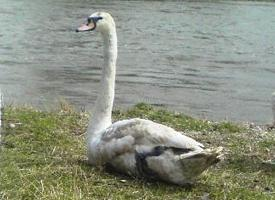
Weights and measures
| Length | from 58 to 80 cm |
|---|---|
| Weight | from 1100 to 2000 g |
| Wingspan | 100 cm |
State of endangerment
| Endangered |
Animal description
The Common Merganser (Mergus merganser), also known as the Goosander in Europe, is a large, striking waterfowl that belongs to the duck family Anatidae. This species exhibits a distinctive sexual dimorphism in its plumage, making males and females easily distinguishable from each other.Males boast a sleek appearance with a dark green, almost black, glossy head, sharply contrasted by a bright white body. The back is black, and the wings are grey with white inner feathers, creating an elegant look during flight. Their beaks are long, red, and hooked at the tip, designed perfectly for their piscivorous diet. During the breeding season, the male's plumage is at its peak, designed to attract females. In the non-breeding season, males molt into a more subdued coloration that more closely resembles the females.
Females, on the other hand, have a more rustic appeal with their grey bodies and a distinctive cinnamon-brown head. A sharp demarcation, often described as a "shaggy" crest, separates the brown head from the grey body, and they also have a white chin patch. Like the males, females have a long, narrow, serrated red beak, adept at catching fish.
Juvenile Common Mergansers resemble females but are generally duller in appearance, with less distinct demarcations between the brown and grey sections of their plumage.
Common Mergansers are large ducks, with lengths ranging from 58 to 72 cm (23 to 28 inches), wingspans of approximately 78 to 97 cm (31 to 38 inches), and weights between 0.9 to 2.1 kg (2.0 to 4.6 lbs). Their bodies are streamlined and built for diving, a skill they utilize to hunt for fish, their primary food source. They are adept swimmers, using their webbed feet to propel themselves underwater with agility and speed.
These birds are found in freshwater lakes, rivers, and coastal areas across the Northern Hemisphere, including North America, Europe, and Asia. They prefer clear water where they can easily spot and dive for fish. During the breeding season, they nest in tree cavities, abandoned holes, or sometimes on the ground near water. The female lays a clutch of 8-12 eggs, which she incubates for about a month. The chicks are precocial and can swim and dive shortly after hatching, though they remain dependent on their mother for food and protection.
Common Mergansers are migratory birds. Populations in the colder regions of their range move south to overwinter in warmer climates, while those in temperate areas may remain year-round if open water is available.
Their diet mainly consists of fish, but they will also eat aquatic invertebrates, amphibians, and small mammals when available. Their specialized beaks are key to their hunting success, allowing them to grasp slippery prey with ease.
Conservation-wise, the Common Merganser is currently classified as Least Concern by the International Union for Conservation of Nature (IUCN), indicating it is not currently at significant risk of extinction. However, like many species, they face threats from habitat destruction, pollution, and climate change, which could impact their food sources and breeding grounds.
In summary, the Common Merganser is a fascinating and visually distinctive bird, adapted to a life of aquatic hunting with its sleek body, specialized beak, and strong swimming abilities. Its presence across a wide range signals a healthy aquatic ecosystem, making it an important species for biodiversity.
Map of occurrence

Similar Animals
New photos of animals
Top 10 animals
- Dolphin gull (Leucophaeus scoresbii)
- Diana monkey (Cercopithecus diana)
- Moustached guenon (Cercopithecus cephus)
- Galápagos tortoise (Geochelone nigra complex)
- Stone loach (Barbatula barbatula)
- Greek tortoise (Testudo graeca)
- Japanese macaque (Macaca fuscata)
- Russian tortoise (Testudo horsfieldii)
- Common flying dragon (Draco volans)
- Galápagos penguin (Spheniscus mendiculus)


